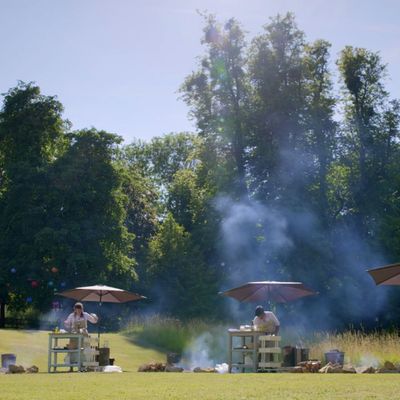
Spoilers ahead for The Great British Baking Show.
The nostalgic, cozy pleasures of The Great British Baking Show have helped to make it one of TV’s most beloved reality programs, but credit is also due to its deceptively simple structure: Each episode features three rounds of complex bakes in the confines of a hot tent on a picturesque British estate, with added commentary from a quartet of personalities sprinkled in. That’s the Baking Show formula — or it was, until something changed in the newest season. For the very first time in the show’s history, the season finale moved contestants Rahul Mandal, Kim-Joy Hewlett, and Ruby Bhogal from the tent to the great outdoors for their technical challenge, where the trio had to make six “campfire pita breads” with baba ghanoush, smoked garlic salsa verde, and burnt-pepper salsa dips. (Kim-Joy owned the challenge, in case you were wondering, even though Rahul was crowned champion in the end.)
The genesis of this relocation — to only about 50 steps away from the tent — came from a desire to expand the show’s tasty horizons. “It was something we only considered for this series,” Baking Show’s executive producer, Kieran Smith, told Vulture. “We are always looking for ways to refresh and reinvigorate challenges, and the technical challenge in the final felt like a good place to take things outdoors.”
Of all the foods that could have been chosen for the technical challenge, Smith says they landed on pita because of its interesting evolution in the culinary world. “Cooking on an open fire is one of the oldest and most primitive forms of cooking. Bread is one of the oldest prepared foods and it is believed that pita is one of the oldest forms of [bread], dating back 14,000 years,” he said. “With this in mind, we wanted an outdoor challenge that tested our bakers’ most basic bread-making instincts with one of the oldest breads and a common purchase amongst supermarket shoppers.”
Producers decided modern equipment wouldn’t be allowed for this “primitive” challenge — though a Dutch oven was briefly considered before they settled on a campfire — so the bakers had to rely on their intuition to mix, knead, and prove the pitas correctly. “If they got any of this wrong, then they simply wouldn’t have well-puffed pitas, no matter which way they were cooked,” Smith said. “Getting the puff to these pitas was crucial, and so they also needed to manage their heat and timing well to allow for the steam.”
The three dips were included, in addition to the pita, as a means of enhancing the dish. “They not only gave the bakers something to do while their bread dough was proving, but also that’s what pitas are for, soaking up juices and dips. It also proved a solid test to see if they could successfully roast vegetables and balance flavors,” Smith noted. “We hoped this would inspire viewers next time they were barbecuing or using a campfire to attempt something similar.”
As for whether Baking Show fans should expect another outdoor challenge in the next season, Smith is pleading the fifth for now. “We keep our challenges a very closely guarded secret,” he said, “and wouldn’t want [there to be] any spoilers for future series.”





